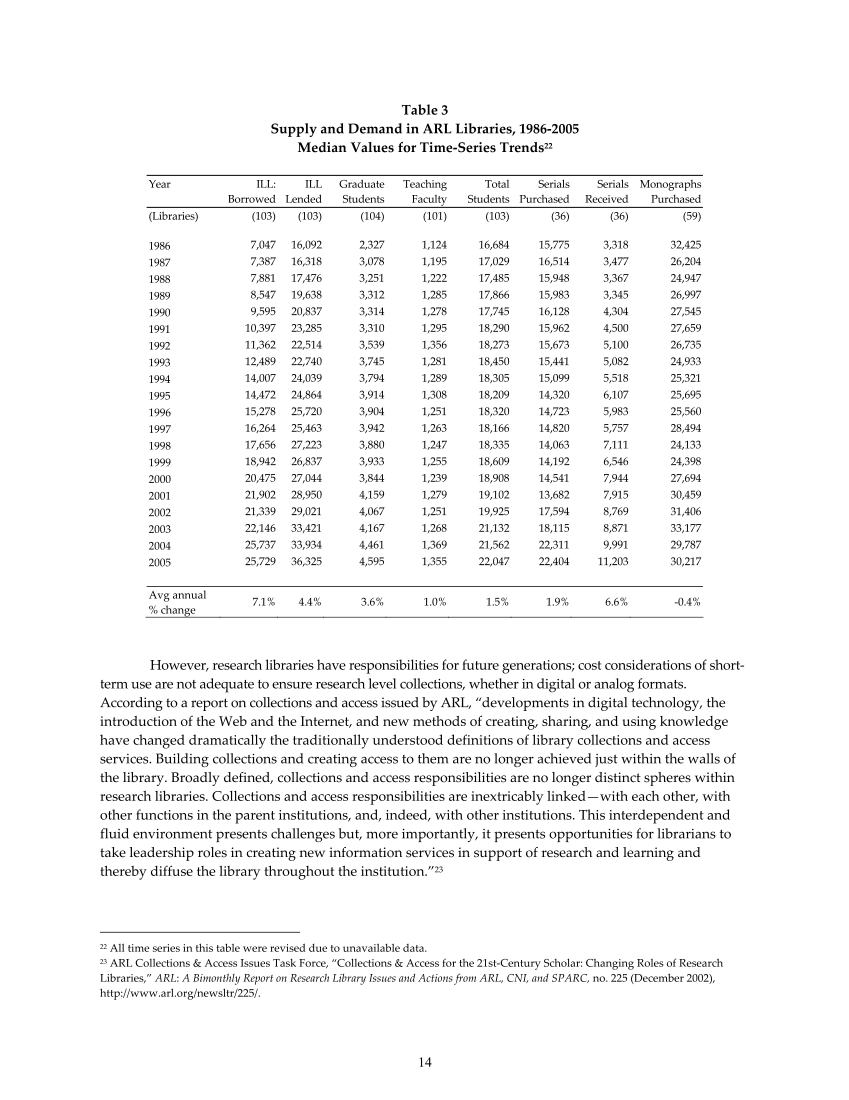14
Table 3
Supply and Demand in ARL Libraries, 1986‐2005
Median Values for Time‐Series Trends22
Year ILL:
Borrowed
ILL
Lended
Graduate
Students
Teaching
Faculty
Total
Students
Serials
Purchased
Serials
Received
Monographs
Purchased
(Libraries) (103) (103) (104) (101) (103) (36) (36) (59)
1986 7,047 16,092 2,327 1,124 16,684 15,775 3,318 32,425
1987 7,387 16,318 3,078 1,195 17,029 16,514 3,477 26,204
1988 7,881 17,476 3,251 1,222 17,485 15,948 3,367 24,947
1989 8,547 19,638 3,312 1,285 17,866 15,983 3,345 26,997
1990 9,595 20,837 3,314 1,278 17,745 16,128 4,304 27,545
1991 10,397 23,285 3,310 1,295 18,290 15,962 4,500 27,659
1992 11,362 22,514 3,539 1,356 18,273 15,673 5,100 26,735
1993 12,489 22,740 3,745 1,281 18,450 15,441 5,082 24,933
1994 14,007 24,039 3,794 1,289 18,305 15,099 5,518 25,321
1995 14,472 24,864 3,914 1,308 18,209 14,320 6,107 25,695
1996 15,278 25,720 3,904 1,251 18,320 14,723 5,983 25,560
1997 16,264 25,463 3,942 1,263 18,166 14,820 5,757 28,494
1998 17,656 27,223 3,880 1,247 18,335 14,063 7,111 24,133
1999 18,942 26,837 3,933 1,255 18,609 14,192 6,546 24,398
2000 20,475 27,044 3,844 1,239 18,908 14,541 7,944 27,694
2001 21,902 28,950 4,159 1,279 19,102 13,682 7,915 30,459
2002 21,339 29,021 4,067 1,251 19,925 17,594 8,769 31,406
2003 22,146 33,421 4,167 1,268 21,132 18,115 8,871 33,177
2004 25,737 33,934 4,461 1,369 21,562 22,311 9,991 29,787
2005 25,729 36,325 4,595 1,355 22,047 22,404 11,203 30,217
Avg annual
%change
7.1% 4.4% 3.6% 1.0% 1.5% 1.9% 6.6% -0.4%
However, research libraries have responsibilities for future generations cost considerations of short‐
term use are not adequate to ensure research level collections, whether in digital or analog formats.
According to a report on collections and access issued by ARL, “developments in digital technology, the
introduction of the Web and the Internet, and new methods of creating, sharing, and using knowledge
have changed dramatically the traditionally understood definitions of library collections and access
services. Building collections and creating access to them are no longer achieved just within the walls of
the library. Broadly defined, collections and access responsibilities are no longer distinct spheres within
research libraries. Collections and access responsibilities are inextricably linked—with each other, with
other functions in the parent institutions, and, indeed, with other institutions. This interdependent and
fluid environment presents challenges but, more importantly, it presents opportunities for librarians to
take leadership roles in creating new information services in support of research and learning and
thereby diffuse the library throughout the institution.”23
22 All time series in this table were revised due to unavailable data.
23 ARL Collections &Access Issues Task Force, “Collections &Access for the 21st‐Century Scholar: Changing Roles of Research
Libraries,” ARL: A Bimonthly Report on Research Library Issues and Actions from ARL, CNI, and SPARC, no. 225 (December 2002),
http://www.arl.org/newsltr/225/.
Table 3
Supply and Demand in ARL Libraries, 1986‐2005
Median Values for Time‐Series Trends22
Year ILL:
Borrowed
ILL
Lended
Graduate
Students
Teaching
Faculty
Total
Students
Serials
Purchased
Serials
Received
Monographs
Purchased
(Libraries) (103) (103) (104) (101) (103) (36) (36) (59)
1986 7,047 16,092 2,327 1,124 16,684 15,775 3,318 32,425
1987 7,387 16,318 3,078 1,195 17,029 16,514 3,477 26,204
1988 7,881 17,476 3,251 1,222 17,485 15,948 3,367 24,947
1989 8,547 19,638 3,312 1,285 17,866 15,983 3,345 26,997
1990 9,595 20,837 3,314 1,278 17,745 16,128 4,304 27,545
1991 10,397 23,285 3,310 1,295 18,290 15,962 4,500 27,659
1992 11,362 22,514 3,539 1,356 18,273 15,673 5,100 26,735
1993 12,489 22,740 3,745 1,281 18,450 15,441 5,082 24,933
1994 14,007 24,039 3,794 1,289 18,305 15,099 5,518 25,321
1995 14,472 24,864 3,914 1,308 18,209 14,320 6,107 25,695
1996 15,278 25,720 3,904 1,251 18,320 14,723 5,983 25,560
1997 16,264 25,463 3,942 1,263 18,166 14,820 5,757 28,494
1998 17,656 27,223 3,880 1,247 18,335 14,063 7,111 24,133
1999 18,942 26,837 3,933 1,255 18,609 14,192 6,546 24,398
2000 20,475 27,044 3,844 1,239 18,908 14,541 7,944 27,694
2001 21,902 28,950 4,159 1,279 19,102 13,682 7,915 30,459
2002 21,339 29,021 4,067 1,251 19,925 17,594 8,769 31,406
2003 22,146 33,421 4,167 1,268 21,132 18,115 8,871 33,177
2004 25,737 33,934 4,461 1,369 21,562 22,311 9,991 29,787
2005 25,729 36,325 4,595 1,355 22,047 22,404 11,203 30,217
Avg annual
%change
7.1% 4.4% 3.6% 1.0% 1.5% 1.9% 6.6% -0.4%
However, research libraries have responsibilities for future generations cost considerations of short‐
term use are not adequate to ensure research level collections, whether in digital or analog formats.
According to a report on collections and access issued by ARL, “developments in digital technology, the
introduction of the Web and the Internet, and new methods of creating, sharing, and using knowledge
have changed dramatically the traditionally understood definitions of library collections and access
services. Building collections and creating access to them are no longer achieved just within the walls of
the library. Broadly defined, collections and access responsibilities are no longer distinct spheres within
research libraries. Collections and access responsibilities are inextricably linked—with each other, with
other functions in the parent institutions, and, indeed, with other institutions. This interdependent and
fluid environment presents challenges but, more importantly, it presents opportunities for librarians to
take leadership roles in creating new information services in support of research and learning and
thereby diffuse the library throughout the institution.”23
22 All time series in this table were revised due to unavailable data.
23 ARL Collections &Access Issues Task Force, “Collections &Access for the 21st‐Century Scholar: Changing Roles of Research
Libraries,” ARL: A Bimonthly Report on Research Library Issues and Actions from ARL, CNI, and SPARC, no. 225 (December 2002),
http://www.arl.org/newsltr/225/.


















































































































































